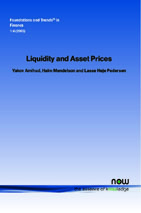Liquidity and Asset Prices
By Yakov Amihud, Stern School of Business, New York University, yamihud@stern.nyu.edu | Haim Mendelson, Graduate School of Business, Stanford University | Lasse Heje Pedersen, Stern School of Business, New York University
Abstract
We review the theories on how liquidity affects the required returns of capital assets and the empirical studies that test these theories. The theory predicts that both the level of liquidity and liquidity risk are priced, and empirical studies find the effects of liquidity on asset prices to be statistically significant and economically important, controlling for traditional risk measures and asset characteristics. Liquidity-based asset pricing empirically helps explain (1) the cross-section of stock returns, (2) how a reduction in stock liquidity result in a reduction in stock prices and an increase in expected stock returns, (3) the yield differential between on- and off-the-run Treasuries, (4) the yield spreads on corporate bonds, (5) the returns on hedge funds, (6) the valuation of closed-end funds, and (7) the low price of certain hard-to-trade securities relative to more liquid counterparts with identical cash flows, such as restricted stocks or illiquid derivatives. Liquidity can thus play a role in resolving a number of asset pricing puzzles such as the small-firm effect, the equity premium puzzle, and the risk-free rate puzzle.
Liquidity and Asset Prices
Liquidity and Asset Prices reviews the literature that studies the relationship between liquidity and asset prices. The authors review the theoretical literature that predicts how liquidity affects a security's required return and discuss the empirical connection between the two. Liquidity and Asset Prices surveys the theory of liquidity-based asset pricing followed by the empirical evidence. The theory section proceeds from basic models with exogenous holding periods to those that incorporate additional elements of risk and endogenous holding periods. The empirical section reviews the evidence on the liquidity premium for stocks, bonds, and other financial assets.
